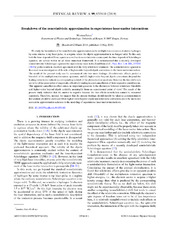Breakdown of the nonrelativistic approximation in superintense laser-matter interactions
Peer reviewed, Journal article
Published version

Åpne
Permanent lenke
https://hdl.handle.net/1956/22312Utgivelsesdato
2019Metadata
Vis full innførselSamlinger
Originalversjon
https://doi.org/10.1103/physreva.99.053410Sammendrag
We study the breakdown of the nonrelativistic approximation in the multiphoton ionization of atomic hydrogen by some intense x-ray laser pulse, in a regime where the dipole approximation is no longer valid. To this end, both the time-dependent Dirac equation as well as its nonrelativistic counterpart, the time-dependent Schrödinger equation, are solved within an ab initio numerical framework. It is demonstrated that a recently developed semirelativistic Schrödinger equation for superintense laser fields [Lindblom et al., Phys. Rev. Lett. 121, 253202 (2018)] yields results in excellent agreement with the fully relativistic treatment. The semirelativistic equation is then used in an investigation of the role of higher-order beyond-dipole corrections to the laser-matter interaction. The result of the present study can be summarized into two main findings: (1) relativistic effects predict a blueshift of the multiphoton ionization spectrum, and (2) higher-order beyond dipole corrections (beyond the leading-order term) indicate a corresponding redshift of the photoelectron spectrum. However, the two shifts turn out to be of the same order of magnitude, effectively leading to a net cancellation of their respective contributions. This apparent cancellation effect raises an important question: Is the distinction between relativistic blueshifts and higher-order beyond dipole redshifts meaningful from an experimental point of view? The result of the present study indicates that the answer is negative because the two effects nonetheless cannot be measured separately. Therefore, instead, we suggest that the present findings should merely be taken as a demonstration that caution should be exercised when higher-order beyond-dipole and relativistic corrections are to be taken into account in approximation schemes in the modeling of superintense laser-matter interactions.